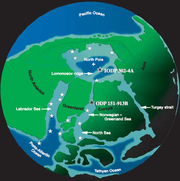
Turgai Sea
Encyclopedia

Epeiric Sea
An epeiric sea is a shallow sea that extends over part of a continent.Epeiric seas are usually associated with the marine transgressions of the geologic past, which have variously been due to either global eustatic sea level changes, local tectonic deformation, or both, and are occasionally...
) of the Mesozoic
Mesozoic
The Mesozoic era is an interval of geological time from about 250 million years ago to about 65 million years ago. It is often referred to as the age of reptiles because reptiles, namely dinosaurs, were the dominant terrestrial and marine vertebrates of the time...
and Cenozoic
Cenozoic
The Cenozoic era is the current and most recent of the three Phanerozoic geological eras and covers the period from 65.5 mya to the present. The era began in the wake of the Cretaceous–Tertiary extinction event at the end of the Cretaceous that saw the demise of the last non-avian dinosaurs and...
Eras. It extended north of the present-day Caspian Sea
Caspian Sea
The Caspian Sea is the largest enclosed body of water on Earth by area, variously classed as the world's largest lake or a full-fledged sea. The sea has a surface area of and a volume of...
to the "paleo-Arctic" region, and was in existence from Middle Jurassic
Middle Jurassic
The Middle Jurassic is the second epoch of the Jurassic Period. It lasted from 176-161 million years ago. In European lithostratigraphy, rocks of this Middle Jurassic age are called the Dogger....
to Oligocene
Oligocene
The Oligocene is a geologic epoch of the Paleogene Period and extends from about 34 million to 23 million years before the present . As with other older geologic periods, the rock beds that define the period are well identified but the exact dates of the start and end of the period are slightly...
times, from approximately 160 to 29 million years ago.
The Turgai Sea was not absolutely continuous throughout this entire era, though it was a persistent and predominating feature in its region; it "fragmented southern Europe and southwestern Asia into many large islands, and separated Europe from Asia."
The division of the Eurasia
Eurasia
Eurasia is a continent or supercontinent comprising the traditional continents of Europe and Asia ; covering about 52,990,000 km2 or about 10.6% of the Earth's surface located primarily in the eastern and northern hemispheres...
n landmass by the Turgai Sea had the effect of isolating animal populations. Perhaps best known to laypeople were the horned dinosaurs
Dinosaur
Dinosaurs are a diverse group of animals of the clade and superorder Dinosauria. They were the dominant terrestrial vertebrates for over 160 million years, from the late Triassic period until the end of the Cretaceous , when the Cretaceous–Paleogene extinction event led to the extinction of...
called Ceratopsia
Ceratopsia
Ceratopsia or Ceratopia is a group of herbivorous, beaked dinosaurs which thrived in what are now North America, Europe, and Asia, during the Cretaceous Period, although ancestral forms lived earlier, in the Jurassic. The earliest known ceratopsian, Yinlong downsi, lived between 161.2 and 155.7...
of the Cretaceous Period, which were restricted to Asia and western North America (which were connected for much of this era). The existence of the Turgai Sea also restricted various freshwater fish and amphibians.
The Turgai Sea derives its name from a region of modern-day Kazakhstan
Kazakhstan
Kazakhstan , officially the Republic of Kazakhstan, is a transcontinental country in Central Asia and Eastern Europe. Ranked as the ninth largest country in the world, it is also the world's largest landlocked country; its territory of is greater than Western Europe...
, with its Turgai River
Turgai River
Turgai is a river that sits in the Turgai Valley in Kazakhstan.It is 825 km long, the surface is 157,000 km². Average water consumption is around 9 cubic meters/second...
and Turgai Valley.

